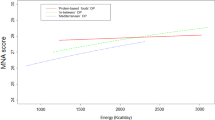Abstract
Objective: The ratio of the total energy intake (TEI) reported by men and women in the same dietary survey varies considerably among dietary surveys. The purpose of our study was to investigate the potential value of the sex ratio of TEI as a measure of misreporting dietary intake by comparing it with the sex ratio of biomarkers such as the 24 h urinary excretion of sodium, potassium and total nitrogen.
Methods: The sex ratio (m/f) of TEI in adults was calculated from 81 dietary surveys performed in 28 countries. The surveys were conducted in healthy and free-living populations, using the same methodology in both sexes.
Results: A mean sex ratio of 1.35 (s.d., 0.13) and 1.33 (s.d., 0.10) was obtained at the individual survey level and at the country level, respectively. The sex ratio of 1.40 in the younger age class (≤60/64 y) was significantly higher than the sex ratio of 1.27 in the older age class (>60/64 y) (P<0.0001). The dietary assessment methodology also influenced the sex ratio (P=0.03). Compared with the INTERSALT study, the sex ratio of TEI was higher than the sex ratios of the 24 h urinary sodium (1.23), potassium (1.20) and total nitrogen (1.25), biomarkers of dietary sodium, potassium and protein intake. Therefore the dietary survey data indicate a mean TEI of 10 476 kJ/d for men and 7784 kJ/d for women, which gives a mean sex difference of 2692 kJ/d. However if the biomarker sex ratio of 1.23, mean sex ratio of the 24 h urinary sodium, potassium and total nitrogen, is correct and the TEI of men is correctly assessed at 10 476 kJ/d, the TEI of women should be 8517 kJ/d, a difference of only 1959 kJ/d.
Conclusions: Calculated from dietary surveys, the mean sex ratio of TEI is 1.35. This sex ratio decreases with age and depends on the dietary assessment methods used. In many dietary surveys, the sex ratio of TEI is likely overestimated.
Sponsorship: Unilever Chair on Nutrition and Health, Catholic University of Leuven, Belgium.
This is a preview of subscription content, access via your institution
Access options
Subscribe to this journal
Receive 12 print issues and online access
$259.00 per year
only $21.58 per issue
Buy this article
- Purchase on Springer Link
- Instant access to full article PDF
Prices may be subject to local taxes which are calculated during checkout
Similar content being viewed by others
Author information
Authors and Affiliations
Contributions
Contributors: Dr J Zhang made the greatest contribution to this paper. Prof H Kesteloot initiated the study and together with Dr EHM Temme participated in the design of the study, the collection and analysis of data, and the critical evaluation of the manuscript.
Guarantor: Prof Dr H Kesteloot functions as guarantor of this paper.
Rights and permissions
About this article
Cite this article
Zhang, J., Temme, E. & Kesteloot, H. Sex ratio of total energy intake in adults: an analysis of dietary surveys. Eur J Clin Nutr 53, 542–551 (1999). https://doi.org/10.1038/sj.ejcn.1600786
Received:
Accepted:
Published:
Issue Date:
DOI: https://doi.org/10.1038/sj.ejcn.1600786



